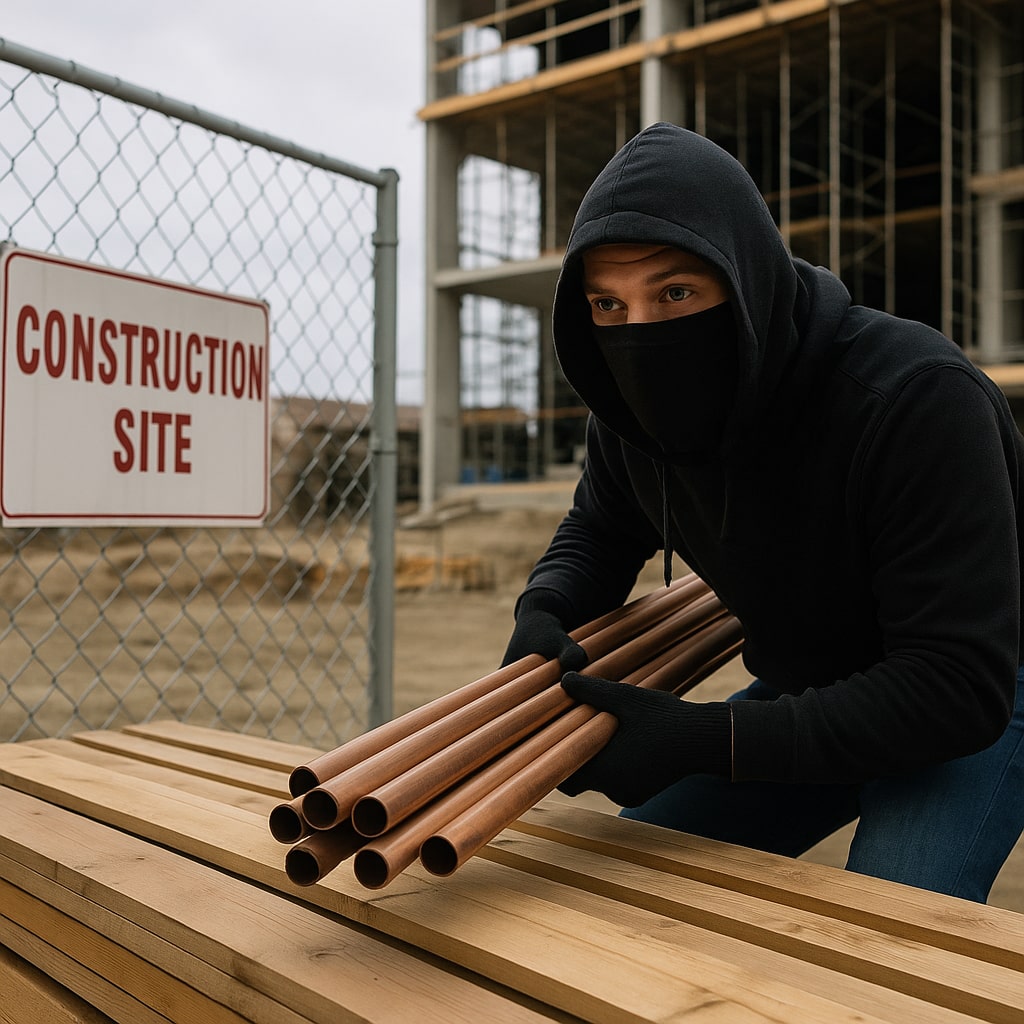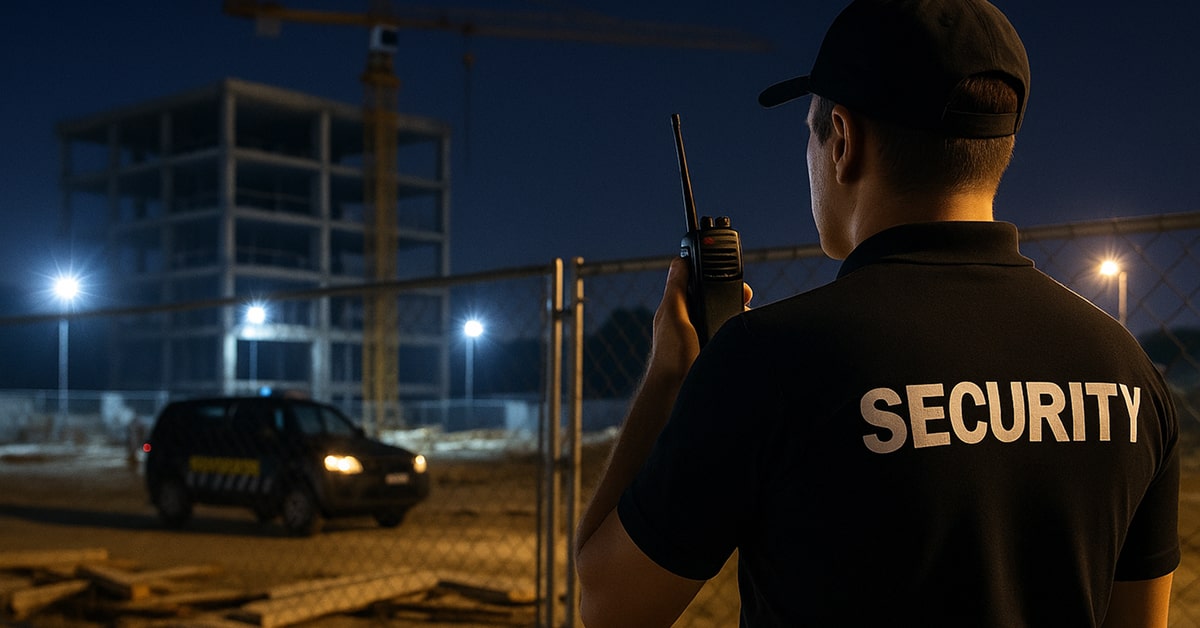Construction sites in Houston are prime targets for theft, vandalism, and unauthorized entry. Heavy equipment, valuable materials, and high visibility make them attractive to criminals. Poor security can lead to project delays, cost overruns, and safety risks.
At 24 & 7 Security & Investigations, we understand the challenges site managers face. For over 20 years, our veteran-led team has provided armed security, executive protection, and mobile surveillance to keep businesses and construction projects safe across Houston.
This guide explains how to secure a construction site effectively. It covers fencing, lighting, guards, and mobile surveillance towers—key steps to protect your assets and workers.
Why Construction Site Security Matters
- Financial loss: Nationally, construction site theft causes annual losses between $400 million and $1 billion.
- Delays & safety: Stolen tools or equipment force delays. Vandalism can introduce hazards affecting worker safety.
- Insurance & costs: Repeated thefts raise insurance premiums. Also, you pay for replacement of equipment and tools.
- Reputation: Poor security can hurt trust with contractors, clients, and local authorities.
If you are site manager in Houston, you face theft risk plus challenges like high urban traffic, job sites being idle overnight, and exposure to weather. A solid security plan reduces risk, protects workers, and protects your bottom line.
Key Components of a Strong Security Plan
To secure a construction site, combine multiple security measures. Relying on just one (e.g. cameras only) leaves gaps. Here are the essential components:
| Component | Purpose | Key Elements |
|---|---|---|
| Perimeter barriers | Prevent unauthorized access | Fencing, locked gates, anti-climb features, clear signage at entry points |
| Lighting | Deter theft or vandalism and improve visibility | Proper lighting, motion sensor floodlights, coverage for gates and equipment storage |
| Access control | Manage who can access the site | Single gate, ID badges, sign-in/out logs, visitor management |
| Security guards | Visible deterrent and rapid response | Armed/unarmed patrols, post orders, incident reporting, coordination with cameras |
| Surveillance & alarm systems | Detect suspicious activity and trigger alerts | Security cameras, remote monitoring, motion detectors, sirens, video-verified alarms |
| Equipment & tools protection | Reduce losses and prevent theft | Secure containers, lockout procedures, GPS trackers, inventory logs, asset marking |
| Security protocols & training | Create accountability and worker safety | Written security plan, daily lock/inspect routines, suspicious activity reporting |
| Review & audits | Adapt to site changes and improve coverage | Regular audits, update access lists, test cameras, alarms, and lighting |
Detailed Steps: How to Secure a Construction Site
Below is a step-by-step guide you can follow, especially tuned for job sites in Houston.
1. Establish a Written Security Plan
- Perform a security audit: walk the future site, identify entry points, blind spots, likely targets for theft, areas where lighting is poor.
- Set security protocols: define who can access the site, how deliveries are managed, how tools are stored overnight, and how to report suspicious activity.
- Identify roles: site manager, supervisor, security guard, etc. Each person should know their responsibility.
- Coordinate with local law enforcement. Let them know about your site, your plan, and how to reach you in emergencies.
2. Fencing, Physical Barriers, and Secure Gates
- Install perimeter fencing around the full site boundary, including storage and tool zones. Use anti-climb or reinforced fencing if possible.
- Use locked gates at all access points. Preferably, limit to a single main entry for vehicles and personnel to simplify control.
- Post signage (“No Trespassing,” “Authorized Personnel Only,” “This site protected by video surveillance / alarm systems”). Signs aid in deterrence and in legal protection.
3. Lighting and Motion Sensors
- Use high-intensity lighting around gates, equipment storage zones, and perimeter fence lines. Proper lighting helps prevent theft or vandalism.
- Use motion-sensor floodlights for parts of the site where constant lighting is not practical. These lights help reveal suspicious activity and can trigger alarm systems.
- Maintain lighting: check bulbs, fixtures, wiring regularly—dark or broken lights create blind spots.
4. Access Control and Managing Entry Points
- Limit entry/exit to controlled points. Use secure gates with locking mechanisms.
- Use ID cards, badges, or electronic access systems for workers, contractors, and visitors. Keep sign-in/out logs.
- Monitor deliveries: schedule them when guards are present. Don’t leave materials unattended and visible outside the fence.
5. Security Guards on Site
- Guards provide active deterrence. They observe suspicious activity, enforce protocols, and respond to alarm triggers.
- Use armed security if your site has high value equipment, or if past incidents suggest high risk. Unarmed guards are useful for regular patrols and monitoring.
- Your guards should also work with surveillance system feeds and alarm system alerts. They need to know how to respond quickly.
6. Alarm Systems and Surveillance Cameras
- Install surveillance cameras that cover all key zones: entry/exit, storage yards, heavy equipment, fences, remote areas. Use high resolution so that images are usable.
- Use remote monitoring if possible. Central monitoring can catch suspicious activity even when no personnel is on site.
- Integrate motion sensors and alarms: sensors trigger lights, alarms or alerts to guards. Alarm systems should include notification via phone, security operations center, or law enforcement as appropriate.
7. Secure Equipment, Tools, and Materials
- Store tools and equipment in locked storage containers or trailers.
- Use GPS trackers on heavy machinery and high-value equipment.
- Maintain an inventory of all tools and devices. Mark tools with identification numbers. Log assignment and check-out.
- Remove unnecessary materials at night; keep fewer items outdoors and in unsecured locations.
8. Worker Training, Reporting, and Suspicious Activity Policies
- Train all workers and contractors on your security protocols: how to lock equipment, report theft, report suspicious activity.
- Encourage everyone to be alert. A casual visitor or subcontractor could be an insider threat.
- Use incident reporting protocols: clear process of who to contact, how to log what happened, what evidence (photos, surveillance footage) to preserve.
9. Review, Audit, and Update Security Measures
- Conduct regular security audits (weekly, or after major changes in site layout). Check lighting, gate locks, camera coverage, any blind spots.
- Update access lists: remove worker access when someone leaves the project. Add new workers properly.
- Test alarm systems, motion sensors, lights, and cameras regularly.

13 Ways to Prevent Unauthorized Access and Theft
Here are specific, actionable measures you can apply, especially in Houston context, to prevent unauthorized entry, theft or vandalism on job sites:
- Layered perimeter security: double fencing or fence with anti-climb topping.
- Solar-powered mobile surveillance towers with motion detection, alerting, remote monitoring.
- Armed and unarmed security guards on patrol, particularly during off-hours.
- Alarm systems tied to motion sensors and remote monitoring.
- High-performance security cameras with night vision or infrared, wide field of view.
- Motion sensor lighting around vulnerable equipment storage and along fence lines.
- Secure equipment storage: chain-linked storage units, lockable tool sheds, trailers.
- GPS tracking devices on heavy machinery.
- Strict access control protocols: badges, sign-in, background checks.
- Clear signage warning about video surveillance, alarm systems, and that the site is guarded.
- Record keeping & inventory of all tools and equipment with IDs or serial numbers.
- Conduct risk assessments yearly or with each stage of construction, adjusting security plan.
- Ensure rapid response capability, via security guard contact, law enforcement coordination, and alarm system matches.
Data & Statistics Relevant to Houston & US Job Sites
While local Houston data is limited in published reports, these national and international studies show trends that apply:
- Over 60% of stolen construction site value comes from tools, heavy equipment, and materials.
- Only about 21% of stolen equipment is recovered.
- Internal theft (by workers or contractors) accounts for a large share of job site losses. Protocols and access control can reduce this risk significantly.
The 24 & 7 Security & Investigations Difference
For more than two decades, 24 & 7 Security & Investigations has protected Houston businesses, construction projects, and high-profile clients. Our team includes military veterans, weapons trainers, and licensed private investigators. We specialize in armed security, executive protection, and mobile surveillance tailored to your project’s needs.
We can evaluate your construction site, identify vulnerabilities, and implement a security plan using fencing, lighting, guards, and surveillance towers. Our goal is to reduce your risk, deter crime, and keep your project on schedule.
Take the Next Step to Secure Your Site
Securing a construction site in Houston demands more than fences and locks. You need a full security plan that combines security guards, alarm systems, surveillance cameras, proper lighting, access control, and strong worker protocols.
These security measures reduce theft, prevent vandalism, improve worker safety, and protect your project timeline and budget. Use the case study above as proof: combining guards and remote monitoring can save thousands.
If you are site manager in Houston and want to build or improve your construction site’s security, contact 24 & 7 Security & Investigations. We will help you design, install, and maintain a layered security protocol that protects your equipment, tools, workers, and reputation.

